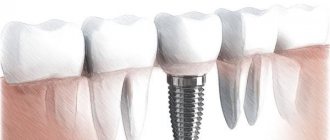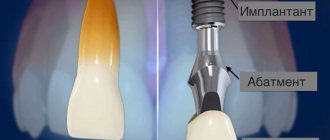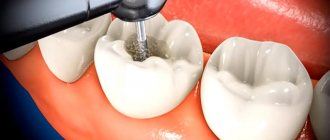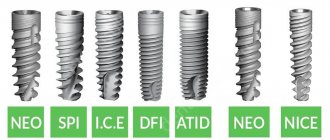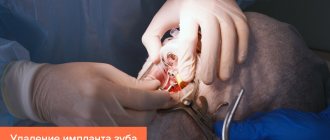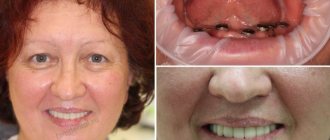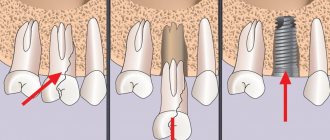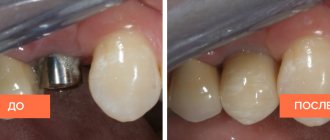From this article you will learn:
- is it possible to smoke after dental implantation,
- How can we reduce the incidence of implant rejection in smokers?
Installing dental implants in smokers is a rather risky undertaking, and there is no doubt that smoking negatively affects the healing of the implant and significantly increases the risk of its rejection. Additionally, clinical studies have shown that there is a direct relationship between the number of cigarettes smoked and the incidence of dental implant failure.
For example, statistics show that the incidence of peri-implantitis and implant rejection in smokers is observed exactly 2 times more often than in non-smoking patients (Fig. 2). This means that approximately 8% of the total number of smokers will experience implant rejection. But still, this does not mean that smoking and dental implants are completely incompatible.
Peri-implantitis (one of the common complications in smokers) –
What could be the consequences?
Most patients believe that the success of this operation depends solely on the specialist who implements the dental implants. If complications occur or the implant is rejected, almost 70% of people begin to blame the doctor and the dental clinic as a whole: they use cheap implants, save on consumables, doctors are not knowledgeable enough about this issue, etc.
In fact, this is not true at all. To a large extent, everything depends on the characteristics of the body and the patient’s behavior during the rehabilitation period. Some bad habits can seriously affect the success of surgery; let’s look at each of them in more detail.
The harm of smoking and its effect on the oral cavity
Smoking affects organs in the mouth in the following ways:
- Hot tobacco smoke provokes darkening of the enamel and the appearance of cracks;
- Dental tissues wear out and may chip;
- Tar and nicotine negatively affect the bone, which becomes brittle and less strong;
- Nicotine negatively affects the immune system, inflammation in the oral cavity often occurs;
- Due to smoke, deposits are formed in the form of stones and dense deposits;
- There is increased salivation due to which inflammatory processes are formed;
- Smoking a hookah after implantation is also dangerous and harmful to human health.
Smoking
Smoking is another dangerous habit. We are not even talking about the effect on the entire body as a whole, but specifically on the condition of the oral cavity. Tobacco smoke contains many harmful impurities. They lead to deterioration of tissue nutrition. This is especially dangerous if the patient has undergone a sinus lift. Let's look at how tobacco smoke is harmful after implantation:
- When you inhale tobacco smoke, a vacuum is created in the oral cavity. This provokes the development of bleeding. Then the wound becomes open - pathogenic microorganisms can enter it and cause inflammation or infection.
- Kurene provokes dry mouth and impaired saliva production - this is an ideal environment for the proliferation of pathogenic microorganisms.
- Healthy cells in the oral cavity are actively dying - this increases the risk of dental implant failure.
Ideally, you should not smoke after implantation for at least one week. Although, not every patient follows this rule.
What happens to implants when smoking –
When smoking, several factors simultaneously affect the healing of implants. Firstly, inhalation of hot smoke actually leads to a slight burn of the tissues of the oral cavity, which is accompanied by hyperkeratosis of the oral mucosa and a slowdown in reparative processes in it. This leads to slower gum healing and increases the risk of developing peri-implantitis.
Secondly, smoking reduces the function of the salivary glands and leads to chronic dryness of the oral mucosa. In turn, this not only impairs gum healing, but also contributes to the accelerated development of pathogenic bacteria, which cause the development of peri-implantitis (inflammation of the gums around the implant, often ending in its rejection).
Thirdly, nicotine and its by-products have a very strong effect on the peripheral blood vessels located in the oral mucosa and superficial layers of bone. Nicotine causes a prolonged spasm of these vessels, which leads to a slowdown in blood flow and, as a consequence, to a decrease in the supply of oxygen and nutrients to the tissues. And this, in turn, leads to disruption of the implant’s healing to the bone.
Conclusions: all of the above factors not only worsen the healing process after implantation surgery, but also worsen the local immunity of the oral mucosa, which leads to a sharp increase in the number of pathogenic bacteria and the development of inflammation in the tissues surrounding the implant (which are already very vulnerable after surgery).
Useful tips
It is not so easy for long-term smokers to give up the bad habit. In this case, experts advise stopping smoking completely for at least two days after surgery, and then significantly reducing the number of cigarettes per day. As for alcohol, there are no concessions here; you need to wait until the mucous membrane has completely healed.
Take dental implants more seriously. Remember that this is a full-scale operation. Since you have decided to restore using this method, try to follow all the recommendations of your doctor.
Smoking after dental implantation reviews
Analyzing patient reviews, we can say that in most cases, implants take root, despite smoking tobacco. But this happens only in those patients who carefully care for their oral cavity. It is necessary to do:
- brushing your teeth at least twice a day;
- use mouthwash, dental floss, irrigator;
- visit a hygienist once every 3-4 months for professional oral hygiene to remove stones and black plaque from smokers.
Dentists recommend stopping smoking after dental implantation, since according to statistics, 8% of smokers experience implant rejection. In addition, this bad habit complicates dental prosthetics in Moscow.
Optimal implant models for smokers
The basal protocol uses special implants that are implanted into the deep and sterile layers of the jawbone. They have a smooth antibacterial coating that prevents the spread of inflammatory processes. A popular brand is Oneway Biomed. For zygomatic implantation and All-on-4, All-on-6, Pro Arch methods, only models from Nobel Biocare and Straumann are used.
When restoring 1-2 teeth, implantologists give preference to implants with an ultrahydrophilic surface. Coated with phosphorus, fluorine, with nanostructures for the correct growth of the thinnest bone partitions (which make up the entire bone mass). This coating attracts calcium and young bone cells, which means that such structures will take root much faster. These include, for example, Nobel Biocare brand implants with TiUnite and TiUltra coatings or Straumann with SLActive surface.
Two-stage implantation in the absence of 1-2 teeth
If a smoking patient needs to restore only 1-2 teeth with implants, then immediate prosthetics will not be suitable (as well as for a non-smoker). Therefore, two methods are possible - classical two-stage implantation with delayed prosthetics and the so-called “early” load.
Classic two-stage technique with crown installation after 3-6 months
The first step is to install the implant. Then it takes root and is overgrown with young bone tissue. In the lower jaw, where the bone is denser, healing occurs in about 3 months, but in smokers it can take up to 4 months. In the upper jaw, healing takes an average of 5-6 months, and in case of poor tissue nutrition, it takes longer. After healing (osseointegration) is complete, a gum former is placed and worn for about 2 weeks. And only then - a permanent crown on the implant. That is, while the implant takes root, you will have to wear a removable “butterfly” prosthesis or an adhesive bridge.
In the best case, it will take six months to restore the tooth. And if it is necessary to pre-treat gums or build up bone tissue (which takes root even worse when smoking), the time will increase.
By suturing the gums at the first stage, it is possible to partially isolate the healing implant from the external influence of cigarettes. But toxins will still penetrate through the blood into surrounding tissues. Another disadvantage is that many months of dietary restrictions (while waiting for a permanent crown) can lead to weak bone growth on the implant. And this is the risk of rejection.
Therefore, the following technique is recommended for single restorations in smoking patients.
Implantation with early prosthetics in 2-8 weeks
The first stage is exactly the same as with the classical method. But due to the fact that special implants are used (they can even be called “smart”), complete osseointegration occurs in just 2-8 weeks. That is, you can very quickly get a permanent crown, start eating nutritiously and smile beautifully.
Myth No. 1: After extraction, any tooth can be replaced with an implant.
In the photo: installed implants immediately after careful tooth extraction
The success of implantation begins with gentle tooth extraction, allowing maximum preservation of the jaw bone without damaging it. It is very important to preserve the walls of the socket, since they are a natural framework for filling the socket with artificial bone granules, which promotes better regeneration of the jaw bone tissue in the socket area or around the implant, if the implantation was carried out in the socket of an extracted tooth.
Therefore, the main condition for simultaneous tooth implantation immediately after extraction is careful preparation and advance planning.
It is worth recalling that under the condition of one-stage implantation, in the case when it is necessary to remove a tooth and replace it with an implant, it is very important to understand: tooth extraction and implant installation occurs in one step, after CAREFUL tooth removal, a dental implant is inserted, after which the crown is already fixed on the tooth .
If time passes after tooth extraction, even 1 day, then installation of the implant is postponed for 2 months until the tooth socket heals and the tissue is restored.
Myth No. 3: Any implant is suitable for emergency implantation
This statement is completely false. The fact is that there are no universal tools. It's the same with implantation.
In the photo: a special implant for emergency dental implantation
For different dental implantation methods, implants of different structures are used, and what is good for classical implantation is not suitable for one-stage implantation.
For one-stage implantation, dental implants of a special structure are used, which allows them to withstand the chewing load immediately after implantation.
Therefore, if you are planning implantation, ask how many implantation systems the dental clinic has. A self-respecting dental clinic that deals with implantation professionally, and not from time to time, has several implantation systems in its arsenal. Sign up for a consultation
Electronic cigarettes after sinus lifting and bone grafting
Vaping (vaping) using electronic cigarettes is also prohibited after sinus lift surgery. Vaping has the same negative aspects as traditional smoking. The patient's oral mucosa dries out, blood vessels spasm, and general health worsens. No sane doctor would allow smoking or vaping after surgery.
The patient may smoke after a sinus lift only at his own risk. However, it is worth weighing the pros and cons before lighting a cigarette. The risks are quite impressive:
- Lost time (implantation is a rather long process) due to non-compliance with recommendations.
- Losing money (sinus lift is an expensive operation), and if the bone tissue does not heal due to smoking, you will have to repeat the surgery.
- Losing your own health. When a patient comes for an implant consultation, their main goal is healthy teeth. However, the smile of a heavy smoker will never be healthy.
Therefore, you should think about whether you really want to sacrifice money, time and your health just for cigarettes? Perhaps the recovery period after a sinus lift is your ideal time to quit your addiction forever and significantly improve your quality of life and health.
Types of implant installation
In addition to non-separable and collapsible implants, there are several other ways to install implants:
- An intraosseous design is used when implanting an implant into the jaw.
- An extraosseous design, which involves implantation of an implant into the periosteum.
- The basal design is used if the bone at the site of implant installation has a loose structure, and there is no place to attach a classic implant. Then they use the basal layer, which is located much deeper than the periosteum.

